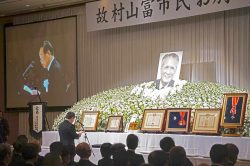16:23 JST, January 10, 2022
Exposure to great works of literature during high school, when students are highly impressionable, has a profound impact on their life going forward. It must be said that the reform of the Japanese language curriculum in high schools, separating literature from practical writing, is unreasonable.
From April, the curriculum guidelines for high schools will be updated. The compulsory subject of integrated Japanese language in which students study a wide range of modern and classic Japanese literature as well as classic Chinese works, will be reorganized into contemporary Japanese language, which will deal with practical writing, and language culture, which will be devoted to literature and classics.
The Education, Culture, Sports, Science and Technology Ministry had expressed it intention to not cover literary works in contemporary Japanese language classes in principle, setting forth a goal of fostering Japanese language skills useful in society.
In the selection of textbooks for contemporary Japanese language to be used by first-year high school students, however, Daiichi Gakushusha Corp.’s textbook containing novels was selected most widely, with a 17% share nationwide.
Daiichi Gakushusha’s textbook had purposely included five novels, including “Rashomon” by Ryunosuke Akutagawa and “Kinosaki nite” (At Kinosaki) by Naoya Shiga, and it had passed the state screening. The company explained that it had decided to include the novels in response to high schools’ requests to do so, creating a stir in this current reform of Japanese language education.
The fact of the matter is schools have been vocal about not having enough time to teach literature due to the reorganization of subjects. Also, other textbook companies have been complaining that they have suffered by following the government’s policy to the letter.
It has been pointed out that the education ministry initially explained to the textbook companies that there was no room to teach literature in contemporary Japanese language classes. The panel that conducts the textbook screening, however, judged that “the inclusion of literature is not totally prohibited and cannot be considered an immediate defect.”
In other countries, there is said to be no distinct separation between literary works and logical writing in school curriculums. Will forcing students to learn the two separately improve their native language skills?
It has been argued that young people’s reading comprehension is declining and their ability to write papers is poor. It is important for them to learn how to read practical texts and write logically, but it should not be a choice between this and literature.
In the 2023 school year, elective courses for second- and third-year high school students will be moved from the current classes of Japanese language expression, contemporary Japanese language A, contemporary Japanese language B, classics A and classics B, to Japanese language (logic), Japanese language (literature), Japanese language expression and advanced classics.
In the future, it is expected that an increasing number of students will choose to take Japanese language (logic), which focuses on practical writing, and advanced classics, because the content is more likely to be used on university entrance exams, leading academic societies to express concerns that this will lead to a neglect of literature.
This heavily criticized reform should not be forcefully pushed forward. It is necessary to revise the system by not drawing a line between literature and logic, so that students can study them in an integrated manner.
— The original Japanese article appeared in The Yomiuri Shimbun on Jan. 10, 2022.
"Editorial & Columns" POPULAR ARTICLE
-

Violations of Subcontract Law: Major Automakers Must Eliminate Old Practices
-

Local Governments’ Tax Revenues: Devise Ways to Correct Imbalances in Tax Sources
-

5 Japanese Business Dinner Mistakes to Avoid — and What They Taught Me About Business in Japan
-

Heavy Rains in Asia: Support for Victims, Flood-Control Measures Urgently Needed
-

Rice Coupons: A Misguided Approach to Countering Rising Prices
JN ACCESS RANKING
-

Keidanren Chairman Yoshinobu Tsutsui Visits Kashiwazaki-Kariwa Nuclear Power Plant; Inspects New Emergency Safety System
-

Imports of Rare Earths from China Facing Delays, May Be Caused by Deterioration of Japan-China Relations
-

University of Tokyo Professor Discusses Japanese Economic Security in Interview Ahead of Forum
-

Tokyo Economic Security Forum to Hold Inaugural Meeting Amid Tense Global Environment
-

Japan Pulls out of Vietnam Nuclear Project, Complicating Hanoi’s Power Plans




















